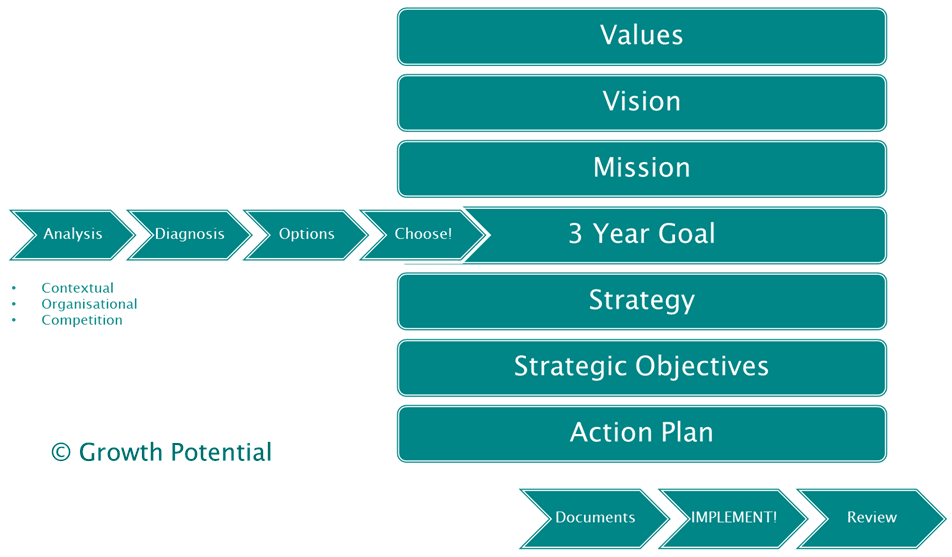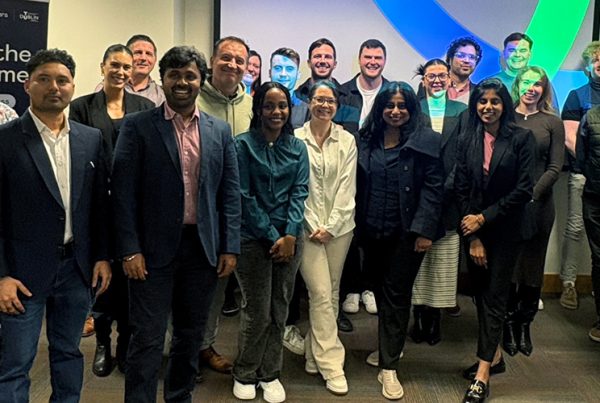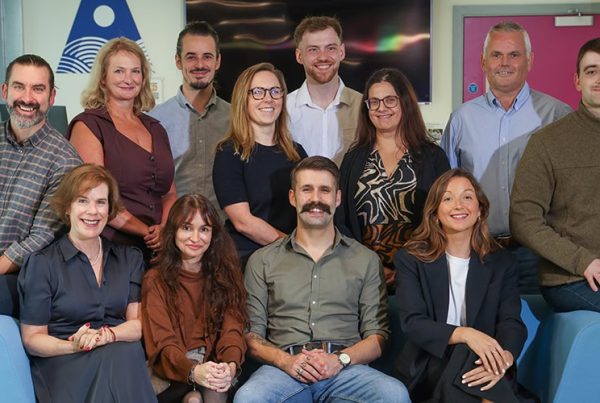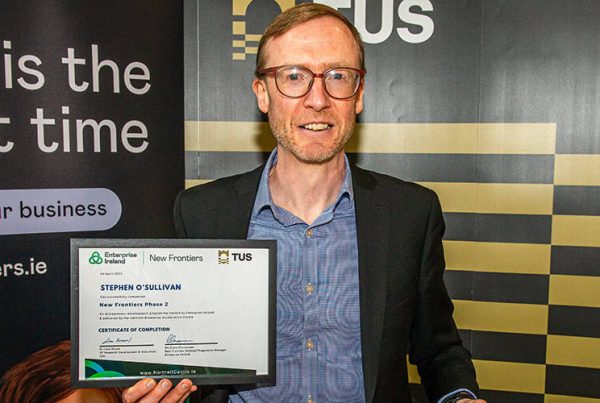
Years ago, when the internet was in its infancy, I was part of a study group that developed a business plan for Intergift, an online shop that would sell books, CDs and other ‘gifts’, complete with reminders for birthdays, anniversaries. Sounds familiar? A year later, Jeff Bezos would start a company called Amazon in his garage.
The point is that loads of people have a great idea. It’s the people who make a decision to prioritise and act on the idea – and then stay with it – who reap the rewards. We did actually set up a company and made some attempts to get something off the ground. However, looking back, what prevented us delivering on a great idea was not dedicating enough time to it and not setting ourselves any goals or action plan, which all resulting in us just not doing it.
Why strategy?
The starting point for a lot of organisations is that people are too busy working away at an operational level making day-to-day things happen. Sometimes, people think they have a common understanding of where the organisation is going, but often – with some probing – it becomes clear that they don’t. Often, ideas about what the organisation might do to support growth are floating around and are either not acted upon at all, or are acted on in an ad hoc way, depending on the forcefulness of the originator of the idea. The development of a proper strategy has the effect of facilitating a common understanding of where the organisation is going, how it’s going to get there and what goals and action are required to make that happen. A lovely analogy I’ve seen is that of a magnet lining all the iron filings up to point in the same direction.
There are various schools of thought on how important goal-setting is in achieving results. Some argue that if you have a strong vision, everything else will fall into place; others, to varying degrees, argue for the necessity of setting goals and developing action plans to deliver those goals. While I’ve no doubt that people have achieved amazing things through vision alone, setting goals and developing action plans generally provides focus and yields better and faster results.
What do you want?
Consider how you would answer the following questions:
- What’s your organisation’s VISION?
That is, what change do you want to see in the world? - What’s your MISSION?
In other words, what is your role in that change? - What’s your TOP LEVEL GOAL?
What is your more specific, measurable, time-bound goal? - What STRATEGY are you going to pursue to deliver on that mission?
What strategic objectives will you set to support that overall strategy? What actions are necessary and when? Who else needs to be involved? How will you measure success?
What’s important to you?
But before embarking on any of this, it’s important to ensure that what you’re setting out to do is in harmony with your values.
Values are principles, standards or qualities we hold to be important. Those cited frequently include integrity, innovation, and family… however, there are a whole host of possibilities, for example: money, success, freedom and loyalty. There is no point in pursuing a mission or goal that conflicts with your organisational values as, eventually, something will give, so it is very important to spend some time identifying values upfront. For example, if conservation or environmental protection is a priority for your organisation, then pursuing goals that conflict with these will not sit well and is unlikely to be successful.
How to build a strategy – the process
Once you’ve defined your values, you can work your way through the process shown, determining your vision and your mission, as defined above. For example, your vision may be that the expected standard of coffee in Ireland would be the same as that in New Zealand and your mission may be to be recognised as the best local cafe(s) in Ireland. Then, it helps to step back and do some analysis, both of the context and of your organisation. What’s the environment like? What forces are at play? What are the key success factors for the industry? How well do you perform versus your competitors? A gap analysis will highlight the knowledge, skills and resources that will help you get from A to B, but also the constraints within which you may have to operate.
There are some great tools to help analysis and understanding of your organisation, for example, a simple SWOT analysis, Osterwalder’s Business Model Canvas, and the ‘Prevailing Logic’ tool.
Next, step back again and take some time to generate some ideas for possible goals and actions that will help you achieve your mission. Again, there are lots of possible approaches, but good old-fashioned brainstorming with a pen and some post-its is still very effective.
It’s now time to define your top level goal – what’s a time-bound, measurable goal you can set yourself in pursuit of your mission? For example, you may decide that you will open your first cafe in Dublin in one year’s time, or that you will have X cafes with a specific profit in 3 years’ time. What’s your strategy to get there – i.e. how are you going to get there? Set yourself five or six smaller strategic objectives – they might be concerned with finance, sourcing of premises, hiring good staff, barista training, roasting training, sourcing of equipment, sourcing of beans – the key is that they, together, will deliver your top level goal and that they are measurable and time-bound.
This is also the time to agree on what you’re NOT going to do. There may well be fantastic ideas generated at the brainstorming phase that have to be parked – the team will have to prioritise and agree what is feasible within agreed resource constraints; what needs to be increased, reduced and eliminated in order to create. No organisation has infinite resources and in order to effectively pursue agreed strategic objectives, it is essential that resources do not get pulled six months down the line to work on someone’s latest hobby horse. Unless, of course, there is an agreed change in strategy.
Action plan
Referring back to the ideas generated during your brainstorming, define the actions necessary to deliver on each of your 5-6 Strategic Objectives. You can download a template to help you organise the action items under each strategic objective from my website. What’s important is that you have the resources to pursue the actions and that you set yourself targets and milestones. It’s also advisable to decide on a small number of KPIs (Key Performance Indicators) that measure how well you’re doing on a month-by-month basis. The downloadable template can be used as a live document to track progress and KPIs.
It’s worth spending a bit of time at this stage considering the risks to your plan and working out some contingency plans.
Review
As many have said before me, “…the only sure thing is change,” so there’s nothing surer than the fact that your plan will require adapting at some stage. In fact, being flexible and being able to respond to changing circumstances is a strength, so periodic review of your plan is important, not just to ensure that you are on track but to ensure that what you’re pursuing and what you’re doing are still relevant.

Maintaining action
The biggest challenge many organisations face is implementation. All too often, they get sucked back into spending all their time on day-to-day operational issues. Dedicating the required resources, accountability and periodic review of the strategic action plan is absolutely critical – otherwise the strategy document will just gather dust on a shelf.
One of the big advantages of determining your mission, setting strategic objectives and detailing an action plan is that all actions should lead back to your mission. Having an action plan allows you to question whether what you’re doing right now is going to bring you closer to your mission. If not, why are you doing it?
About the author

Mary Carroll
Mary Carroll is a business strategist and coach with over 25 years’ experience in design engineering, management consulting and business development. She is also an Enterprise Ireland mentor.
Mary has worked in senior management and management consulting roles across various sectors. She has supported clients in personal growth, business process change, systems implementation, technology acquisitions, strategy development and planning. Her areas of interest include: strategy, business process optimisation, analysis, inclusion, diversity, gender balance, women in business, business coaching, mentoring, executive coaching, business consulting, programme management, and project management.
Recent articles

Startup In Dublin: Learn More About New Frontiers On TU Dublin’s Grangegorman Campus

Michael Furey On The Success Of Ronspot: “The Most Important Thing Is Research”

Showcase Day Celebrates Twelve Ambitious Founders In County Dublin (IADT & NovaUCD)

Scientist Turned Founder Margaret Rae Is Building A Prevention System For The Aquaculture Sector

I Left You A Note Turns Negatives Into Positives For Hotels

Extend Your Startup’s R&D Capability With Enterprise Ireland Innovation Vouchers

A Cohort Of Fifteen Founders Graduates From New Frontiers In Grangegorman


